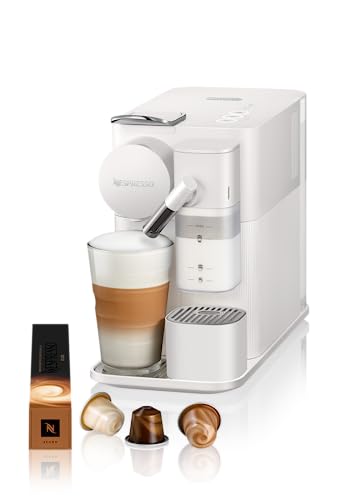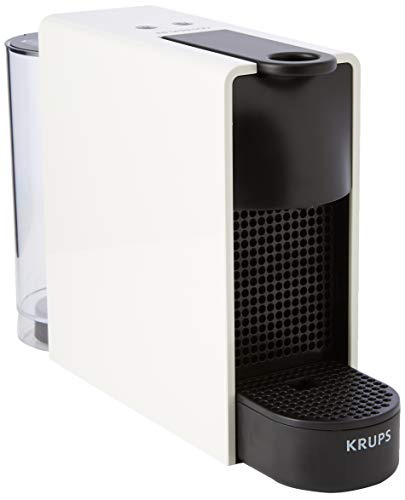9 Things Your Parents Taught You About Nespresso Coffeee Machine
페이지 정보
작성자 Roberta 작성일24-06-03 12:36 조회886회 댓글0건관련링크
본문
 Nespresso Coffee - The Essenza Mini
Nespresso Coffee - The Essenza MiniThe Essenza Mini is compact and affordable. It's also very easy to use. It doesn't have features like a water tank or removable drip tray to stay compact, but it does make excellent lungo and espresso.
It is operated by piercing capsules and then pumping hot water under pressure to make different espresso and coffee sizes, such as the 1.35-ounce espresso, 2.7-ounce double espresso, 5-ounce gran lungo or 14-ounce alto. It can be used in conjunction with an independent milk frother.
Capsules
With the Nespresso system you can make your coffee at the push of a button. You can choose a single-serving size or a larger cup and each capsule has the proper amount of ground beans to meet your desired strength. You can also add milk powder to make the creation of a cappuccino or latte macchiato. The capsules are made of biodegradable and non-toxic materials that can be disposed of or recycled in a way that is guilt-free.
The pods are constructed of aluminum and are able to be able to withstand the pressure of the machine. The pods are sealed in a hermetically sealed manner and are tamper-proof, and the coffee grounds inside are fresh and protected from oxygen and moisture. Nestle's environmental goals are in line with the fact that Magimix Aluminium Nespresso Pixie Coffee Machine - 0.7L is 100% recyclable.
The system comes with its own drawbacks. The machines are expensive both to buy and to operate. The capsules are also costly to purchase and must be replaced regularly. Also, the machines are only compatible with Nespresso-branded capsules. This has led to numerous lawsuits between Nestle and third-party companies that utilize the same extraction techniques and ingredients as Nespresso.
Despite these limitations, the Nespresso system is a great option for many reasons which include premium coffee and environmental sustainability. It is an excellent alternative to regular coffee and tea bags, and has an even higher extraction rate than other single-serve systems. In fact, one capsule can yield up to 14 ounces of espresso coffee.
The original capsule design was developed in 1976 and patented in 1979. The main characteristics of the capsule include an cone of aluminum, a flattop with a cylindrical recess through which the machine pumps water, and a small opening in the bottom which is punctured both above and below. The machine then spins the capsule at 7000 rpm to infuse the coffee with water and produce a thick crema.
Water
When you use a Nespresso machine, it's crucial to have high-quality water. This ensures consistent quality and is important for taste and texture. Ideally, you should use water that has been "filtered" or "spring," and avoid tap or distillation water.
In our lab tests we found that machines that have softened water make more satisfying espressos and lungos than machines with hard water. Hard water can cause calcium deposits and other problems that impact the taste of your coffee.
During each cup of coffee, the Nespresso machine infuses and then releases hot water under high pressure. This process is known as extraction. The temperature, duration and pressure of the extraction process determines the flavor and intensity.
The original machines cut the capsule and then pump it, while the Vertuo model scans the barcodes to determine the amount of water required for each espresso. The Vertuo models can make six different sizes of drinks including lungos and espressos with or without a cap of foam.
All machines that are part of the Nespresso line can produce 19 bars. Some of the more expensive models can also brew cappuccinos as well as macchiatos with latte, and some even offer the option of making Iced Coffee.
The Inissia and U series machines have compact bodies, which makes them ideal for tight spaces. The Nespresso Pixie, which has a built-in frother, is another compact option. It can also be used with the Nespresso app to access custom recipes and order capsules. Nespresso is an excellent choice for those looking to reduce their footprint on the environment while also supporting the company's sustainability program.
Temperature
While Nespresso machines may be more complicated than your average coffee maker, they're also designed for speed and ease of use. Each capsule is prepared in a matter of seconds. They are also quite energy efficient. Nespresso machines consume less energy than traditional drip coffee makers to make the capsules.
Most Nespresso coffeee machine are designed for espresso-based drinks, but certain models come with milk frothers that can be used to make lattes and cappuccinos. Certain models come with a capsule container that can hold up to 12 capsules at once. This makes it easy to recycle.
The Nespresso brand is supported by several well-known kitchen equipment manufacturers, including Krups Nespresso Atelier Coffee Pod Machine with Frother DeLonghi and Breville. The majority of the machines are manufactured by Eugster/Frismag which is a Swiss company that is one of the largest coffee-machine makers. This has led to criticism of the company's usage of patents and other strategies similar like those employed by printer manufacturers to create lock-ins for vendors.
Pressure
In order to make the best possible espresso it is essential to ensure that you maintain a consistent pressure throughout the extraction process. This is referred to as "pressure profiling." Pressure profiling entails adjusting the amount of pressure applied to the coffee grounds to ensure a perfect extraction and to maximize flavor. This method is possible by using various espresso machines, such as Nespresso coffee makers.
There are a number of different ways espresso machines manipulate pressure during the extraction process. A balanced bypass keeps the water pressure to a set value, usually 9 bar regardless of the inlet. This is a simple and effective method that ensures that all of the espresso groups have the same pressure during the extraction process.
A lever or control knob can be used to manually adjust pressure. This method is more difficult, but can provide more flexibility and control. It is important to note that manual pressure regulation could lead to inconsistent results, so it requires a high degree of skill and concentration.
Finally, some espresso machines have a dynamic pump that adjusts the pressure according to the temperature of the grounds and the type of coffee being used. This system is more advanced, but can produce better results than other models.
Nespresso offers a range of machines that can make lungo and espresso drinks and some can also frother milk. The Nespresso Inissia is a fantastic machine for baristas at home. It can make anywhere from 7 to 9 espressos at a time and has an in-built water tank that can hold 33 ounces. The machine also has buttons for various sizes of drinks as well as the capsule tray, which can hold up to nine pods. The Nespresso Vertuo Next is designed to be versatile and comes with eleven milk temperatures and eight textures to choose from. It also comes with stainless steel milk frother as well as the container that can hold up to 18 pounds.
Cleaning
Each time you use a Nespresso it will leave behind limescale and mineral residues. They can be mixed with your coffee and cause it to taste off. To avoid this from happening, it is essential to regularly clean your Nespresso machine and its parts. The removable parts such as the drip tray, capsule container and washer must be cleaned and decalked after a thorough cleaning. A daily wash of the capsule container with fresh water can also help stop the buildup of mineral.
Using a de-scaling solution can help eliminate mineral deposits from your machine. You can find these products at most coffee and appliance stores. Alternatively, you can try using vinegar. This gentle cleaner won't harm your machine, however it may take longer for the minerals to dissolve than a descaling solution.
If you choose to make use of vinegar, you must first take out the coffee pods and empty the water reservoir. Then, drain the remaining water in the tank and any water filters built-in. Pour in the vinegar and run a brew process without a coffee pod to allow it to pass through the machine. Rinse the machine using clean water and run several times to ensure that there are no vinegar traces left.
 After cleaning your machine, you can clean the exterior and the removable parts. Pay particular attention to corners and crevices where gunk could hide. You can clean the parts that are removable using mild soap in the dishwasher or by hand. Rinse them thoroughly. It is also recommended to examine the seals around the capsule and the coffee outlet and replace them as needed to ensure their elasticity and to prevent leaks.
After cleaning your machine, you can clean the exterior and the removable parts. Pay particular attention to corners and crevices where gunk could hide. You can clean the parts that are removable using mild soap in the dishwasher or by hand. Rinse them thoroughly. It is also recommended to examine the seals around the capsule and the coffee outlet and replace them as needed to ensure their elasticity and to prevent leaks.댓글목록
등록된 댓글이 없습니다.



